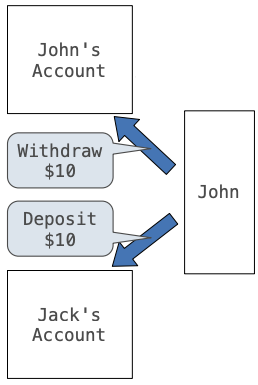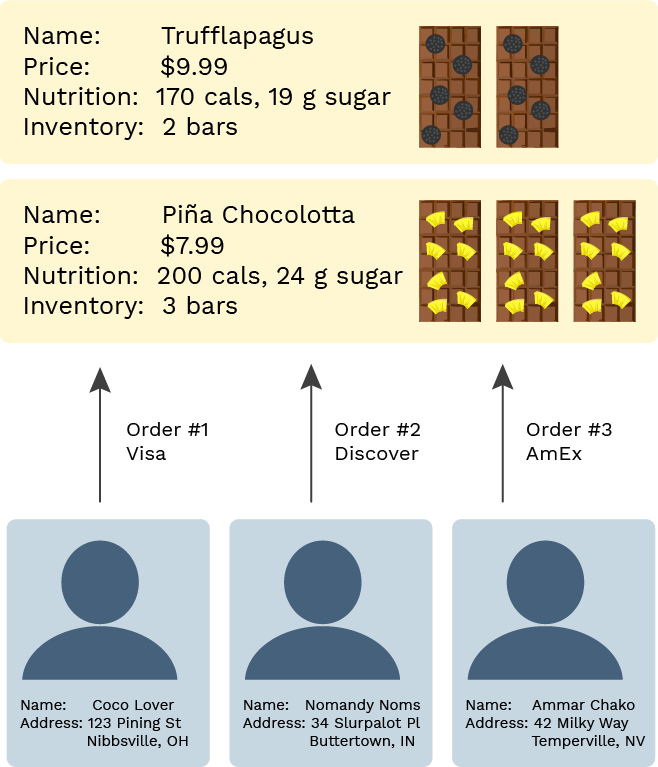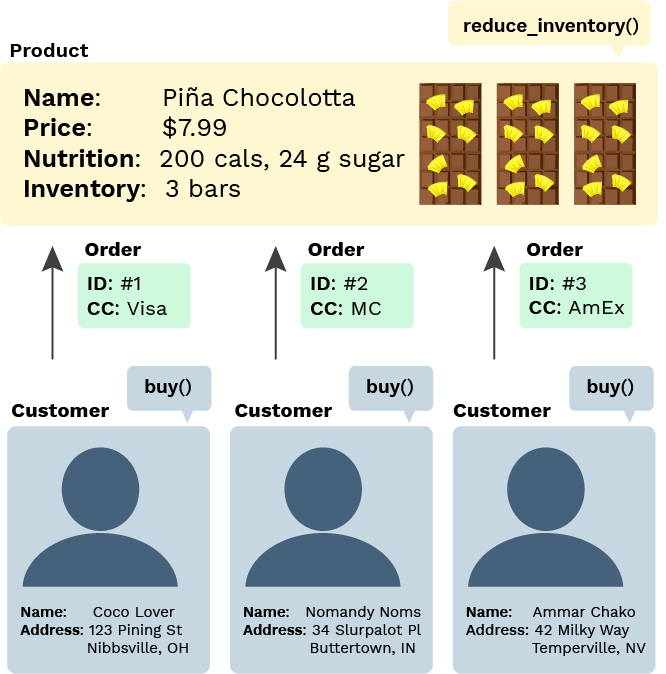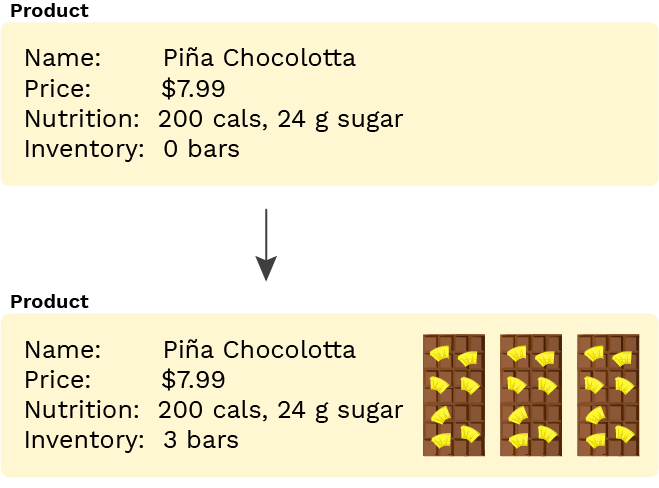Objects
- Press O or Escape for overview mode.
- Press the copy icon on the upper right of code blocks to copy the code
Class outline:
- Object-oriented programming
- The class statement
- Class methods
- Instance variables
- Class variables
Object-oriented programming
OOP is a method for organizing programs which includes:
- Data abstraction
- Bundling together information and related behavior
A metaphor for computation using distributed state:
- Each object has its own local state
- Each object also knows how to manage its own local state, based on method calls
- Method calls are messages passed between objects
- Several objects may all be instances of a common type
- Different types may relate to each other

An OOP shop
Building a chocolate shop

Building a chocolate shop
We could make data abstractions using functions:
# Inventory tracking
add_product(name, price, nutrition)
get_label(product)
get_nutrition_info(product)
increase_inventory(product, amount)
reduce_inventory(product, amount)
# Customer tracking
signup_customer(name, address)
get_greeting(customer)
get_formatted_address(customer)
# Purchase tracking
order(customer, product, quantity, cc_info)
track(order_number)
refund(order_number, reason)

That codebase would be organized around functions.
The OOP approach
We can use objects to organize our code for the shop:
# Inventory tracking
Product(name, price, nutrition)
Product.get_label()
Product.get_nutrition_info()
Product.increase_inventory(amount)
Product.reduce_inventory(amount)
Product.get_inventory_report()
# Customer tracking
Customer(name, address)
Customer.get_greeting()
Customer.get_formatted_address()
Customer.buy(product, quantity, cc_info)
# Purchase tracking
Order(customer, product, quantity, cc_info)
Order.ship()
Order.refund(reason)
# Shop management
ChocolateShop(name)
ChocolateShop.signup_customer(name, address)
ChocolateShop.add_product(name, price, nutrition)

An object bundles together information and related behavior.
Python OOP terminology
- A class is a template for defining new data types.
- An instance of a class is called an object.
- Each object has data attributes called instance variables that describe its state.
- Each object also has function attributes called methods.

Python includes special syntax to create classes and objects.
Classes
A fully coded class and usage
# Define a new type of data
class Product:
# Set the initial values
def __init__(self, name, price, nutrition_info):
self.name = name
self.price = price
self.nutrition_info = nutrition_info
self.inventory = 0
# Define methods
def increase_inventory(self, amount):
self.inventory += amount
def reduce_inventory(self, amount):
self.inventory -= amount
def get_label(self):
return "Foxolate Shop: " + self.name
def get_inventory_report(self):
if self.inventory == 0:
return "There are no bars!"
return f"There are {self.inventory} bars."
pina_bar = Product("Piña Chocolotta", 7.99,
["200 calories", "24 g sugar"])
pina_bar.increase_inventory(2)
Let's break it down...
Class
Each object is an instance of a class. The class is the object's type.
class <name>:
<suite>
class Product:
<suite>
class Customer:
<suite>
class Order:
<suite>
What's in a class?
A class can:
- Set the initial values for instance variables.
- Define methods specific to the object, often used to change or report the values of instance variables.
class Product:
# Set the initial values
# Define methods
class Product:
def __init__(self, name, price, nutrition_info):
def increase_inventory(self, amount):
def reduce_inventory(self, amount):
def get_label(self):
def get_inventory_report(self):
Class instantiation (Object construction)
pina_bar = Product("Piña Chocolotta", 7.99,
["200 calories", "24 g sugar"])
Product(args) is often called the constructor.
When the constructor is called:
- A new instance of that class is created
- The
__init__method of the class is called with the new object as its first argument (namedself), along with any additional arguments provided in the call expression
class Product:
def __init__(self, name, price, nutrition_info):
self.name = name
self.price = price
self.nutrition_info = nutrition_info
self.inventory = 0
Instance variables
Instance variables are data attributes that describe the state of an object.
This __init__ initializes 4 instance variables:
class Product:
def __init__(self, name, price, nutrition_info):
self.name = name
self.price = price
self.nutrition_info = nutrition_info
self.inventory = 0
The object's methods can then change the values of those variables or assign new variables.
Method invocation
This expression...
pina_bar.increase_inventory(2)
...calls this function in the class definition:
class Product:
def increase_inventory(self, amount):
self.inventory += amount
pina_bar.increase_inventory is a bound method:
a function which has its first parameter pre-bound to a particular value.
In this case, self is pre-bound to pina_bar
and amount is set to 2.
It's equivalent to:
Product.increase_inventory(pina_bar, 2)
Dot notation
All object attributes (which includes variables and methods) can be accessed with dot notation:
pina_bar.increase_inventory(2)
That evaluates to the value of the attribute looked up by increase_inventory
in the object referenced by pina_bar.
The left-hand side of the dot notation can also be any expression that evaluates to an object reference:
bars = [pina_bar, truffle_bar]
bars[0].increase_inventory(2)
All together now
The class definition:
# Define a new type of data
class Product:
# Set the initial values
def __init__(self, name, price, nutrition_info):
self.name = name
self.price = price
self.nutrition_info = nutrition_info
self.inventory = 0
# Define methods
def increase_inventory(self, amount):
self.inventory += amount
def reduce_inventory(self, amount):
self.inventory -= amount
Object instantiation and method invocation:
pina_bar = Product("Piña Chocolotta", 7.99,
["200 calories", "24 g sugar"])
pina_bar.increase_inventory(2)
Exercise: Player class
"""
This class represents a player in a video game.
It tracks their name and health.
"""
class Player:
"""
>>> player = Player("Mario")
>>> player.name
'Mario'
>>> player.health
100
>>> player.damage(10)
>>> player.health
90
>>> player.boost(5)
>>> player.health
95
"""
Exercise: Player class (solution)
"""
This class represents a player in a video game.
It tracks their name and health.
"""
class Player:
"""
>>> player = Player("Mario")
>>> player.name
'Mario'
>>> player.health
100
>>> player.damage(10)
>>> player.health
90
>>> player.boost(5)
>>> player.health
95
"""
def __init__(self, name):
self.name = name
self.health = 100
def damage(self, amount):
self.health -= amount
def boost(self, amount):
self.health += amount
Exercise: Clothing class
"""
Clothing is a class that represents pieces of clothing in a closet. It tracks
the color, category, and clean/dirty state.
"""
class Clothing:
"""
>>> blue_shirt = Clothing("shirt", "blue")
>>> blue_shirt.category
'shirt'
>>> blue_shirt.color
'blue'
>>> blue_shirt.is_clean
True
>>> blue_shirt.wear()
>>> blue_shirt.is_clean
False
>>> blue_shirt.clean()
>>> blue_shirt.is_clean
True
"""
Exercise: Clothing class (solution)
"""
Clothing is a class that represents pieces of clothing in a closet. It tracks
the color, category, and clean/dirty state.
"""
class Clothing:
"""
>>> blue_shirt = Clothing("shirt", "blue")
>>> blue_shirt.category
'shirt'
>>> blue_shirt.color
'blue'
>>> blue_shirt.is_clean
True
>>> blue_shirt.wear()
>>> blue_shirt.is_clean
False
>>> blue_shirt.clean()
>>> blue_shirt.is_clean
True
"""
def __init__(self, category, color):
self.category = category
self.color = color
self.is_clean = True
def wear(self):
self.is_clean = False
def clean(self):
self.is_clean = True
Dynamic attributes
Classes in environment diagrams
class Product:
def __init__(self, name, price, nutrition_info):
def increase_inventory(self, amount):
def reduce_inventory(self, amount):
def get_label(self):
def get_inventory_report(self):
- A class statement creates a new class and binds that class to the class name in the first frame of the current environment.
- Inner
defstatements create attributes of the class (not names in frames).
Dynamic instance variables
An object can create a new instance variable whenever it'd like.
class Product:
def reduce_inventory(self, amount):
if (self.inventory - amount) <= 0:
self.needs_restocking = True
self.inventory -= amount
pina_bar = Product("Piña Chocolotta", 7.99,
["200 calories", "24 g sugar"])
pina_bar.reduce_inventory(1)
Now pina_bar has an updated binding for
inventory
and a new binding for needs_restocking (which was not in __init__).
Class variables
Class variables
A class variable is an assignment inside the class that isn't inside a method body.
class Product:
sales_tax = 0.07
Class variables are "shared" across all instances of a class because they are attributes of the class, not the instance.
class Product:
sales_tax = 0.07
def get_total_price(self, quantity):
return (self.price * (1 + self.sales_tax)) * quantity
pina_bar = Product("Piña Chocolotta", 7.99,
["200 calories", "24 g sugar"])
truffle_bar = Product("Truffalapagus", 9.99,
["170 calories", "19 g sugar"])
pina_bar.sales_tax
truffle_bar.sales_tax
pina_bar.get_total_price(4)
truffle_bar.get_total_price(4)
Exercise: StudentGrade class
"""
This class represents grades for students in a class.
"""
class StudentGrade:
"""
>>> grade1 = StudentGrade("Arfur Artery", 300)
>>> grade1.is_failing()
False
>>> grade2 = StudentGrade("MoMo OhNo", 158)
>>> grade2.is_failing()
True
>>> grade1.failing_grade
159
>>> grade2.failing_grade
159
>>> StudentGrade.failing_grade
159
>>>
"""
def __init__(self, student_name, num_points):
self.student_name = student_name
self.num_points = num_points
def is_failing(self):
return self.num_points < ___
Exercise: StudentGrade class (solution)
"""
This class represents grades for students in a class.
"""
class StudentGrade:
"""
>>> grade1 = StudentGrade("Arfur Artery", 300)
>>> grade1.is_failing()
False
>>> grade2 = StudentGrade("MoMo OhNo", 158)
>>> grade2.is_failing()
True
>>> grade1.failing_grade
159
>>> grade2.failing_grade
159
>>> StudentGrade.failing_grade
159
>>>
"""
failing_grade = 159
def __init__(self, student_name, num_points):
self.student_name = student_name
self.num_points = num_points
def is_failing(self):
return self.num_points < self.failing_grade
Accessing attributes
getattr/hasattr built-ins
Using getattr, we can look up an attribute using a string
getattr(pina_bar, 'inventory') # 1
hasattr(pina_bar, 'reduce_inventory') # True
getattr and dot expressions look up a name in the same way
Looking up an attribute name in an object may return:
- One of its instance attributes, or
- One of the attributes of its class
Public vs. Private
Attributes are all public
As long as you have a reference to an object, you can access or change any attributes.
pina_bar = Product("Piña Chocolotta", 7.99,
["200 calories", "24 g sugar"])
current = pina_bar.inventory
pina_bar.inventory = 5000000
pina_bar.inventory = -5000
You can even assign new instance variables:
pina_bar.brand_new_attribute_haha = "instanception"
"Private" attributes
To communicate the desired access level of attributes, Python programmers generally use this convention:
__(double underscore) before very private attribute names_(single underscore) before semi-private attribute names- no underscore before public attribute names
That allows classes to hide implementation details and add additional error checking.
Quiz: Objects + Classes
Multiple instances
There can be multiple instances of each class.
pina_bar = Product("Piña Chocolotta", 7.99,
["200 calories", "24 g sugar"])
cust1 = Customer("Coco Lover",
["123 Pining St", "Nibbsville", "OH"])
cust2 = Customer("Nomandy Noms",
["34 Shlurpalot St", "Buttertown", "IN"])
What are the classes here?
Product, Customer
How many instances of each?
1 Product, 2 Customer
State management
An object can use instance variables to describe its state. A best practice is to hide the representation of the state and manage it entirely via method calls.
>>> pina_bar = Product("Piña Chocolotta", 7.99,
["200 calories", "24 g sugar"])
>>> pina_bar.get_inventory_report()
"There are NO bars!"
>>> pina_bar.increase_inventory(3)
>>> pina_bar.get_inventory_report()
"There are 3 bars total (worth $23.97 total)."

What's the initial state? 0 bars in inventory
What changes the state? increase_inventory() by changing the instance variable _inventory
Class vs. instance variables
class Customer:
salutation = "Dear"
def __init__(self, name, address):
self.name = name
self.address = address
def get_greeting(self):
return f"{self.salutation} {self.name},"
def get_formatted_address(self):
return "\n".join(self.address)
cust1 = Customer("Coco Lover",
["123 Pining St", "Nibbsville", "OH"])
What are the class variables? salutation
What are the instance variables? name, address